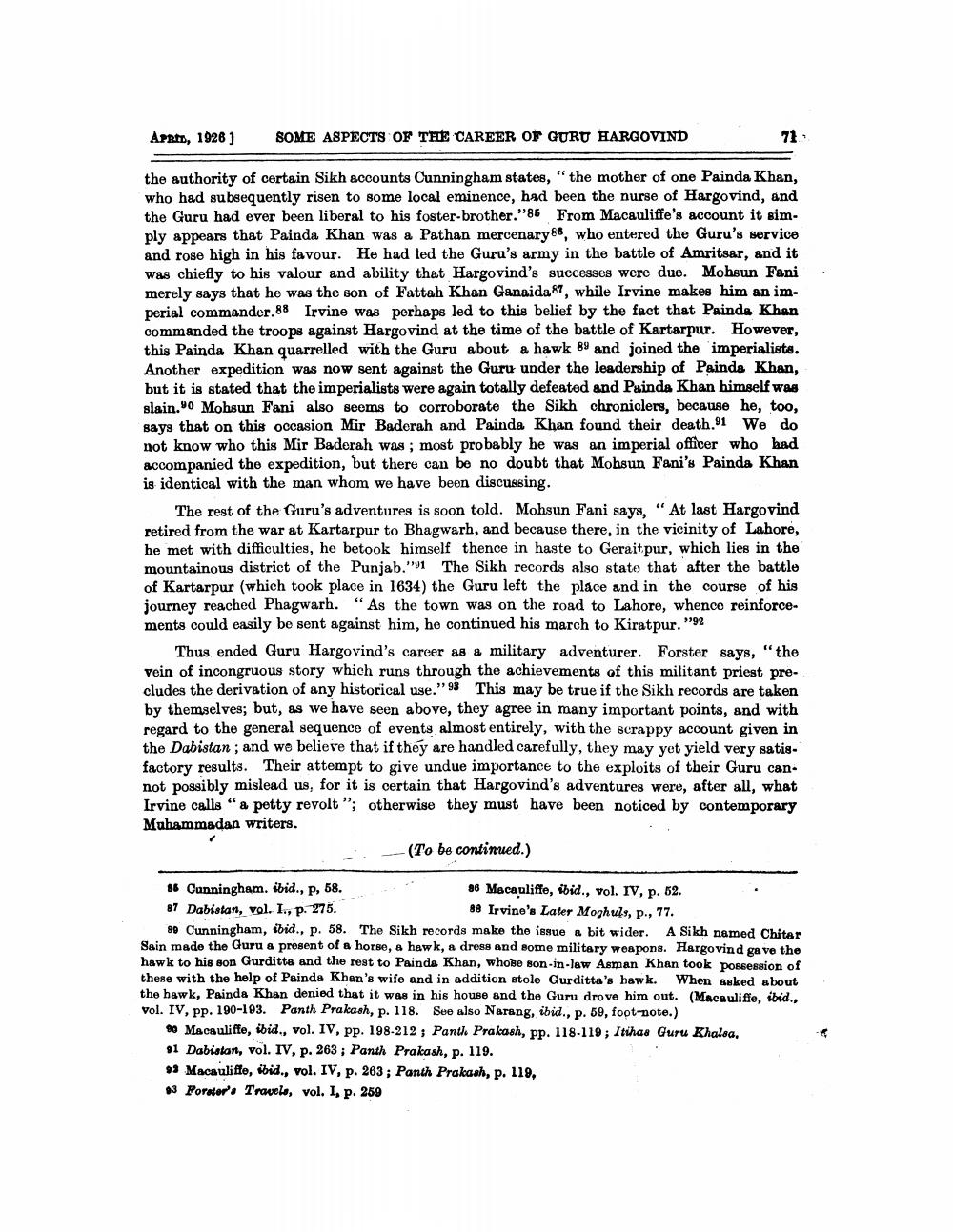________________
Aprto, 1926 )
SOME ASPECTS OF THE CAREER OF QURU HARGOVIND
71
the authority of certain Sikh accounts Cunningham states, "the mother of one Painda Khan, who had subsequently risen to some local eminence, had been the nurse of Hargovind, and the Guru had ever been liberal to his foster-brother."86 From Macauliffe's account it simply appears that Painda Khan was a Pathan mercenary 88, who entered the Guru's service and rose high in his favour. He had led the Guru's army in the battle of Amritsar, and it was chiefly to his valour and ability that Hargovind's successes were due. Mohsun Fani merely says that he was the son of Fattah Khan Ganaida 87, while Irvine makes him an imperial commander.88 Irvine was perhaps led to this belief by the fact that Painda Khan commanded the troops against Hargovind at the time of the battle of Kartarpur. However, this Painda Khan quarrelled with the Guru about a hawk 89 and joined the imperialiste. Another expedition was now sent against the Guru under the leadership of Painda Khan, but it is stated that the imperialists were again totally defeated and Painda Khan himself was slain.” Mohsun Fani also seems to corroborate the Sikh chroniclers, because he, too, says that on this occasion Mir Baderah and Painda Khan found their death.91 We do not know who this Mir Baderah was; most probably he was an imperial officer who had accompanied the expedition, but there can be no doubt that Mohsun Fani's Painda Khan is identical with the man whom we have been discussing.
The rest of the Guru's adventures is soon told. Mohsun Fani says, "At last Hargovind retired from the war at Kartarpur to Bhagwarh, and because there, in the vicinity of Lahore, he met with difficulties, he betook himself thence in haste to Geraitpur, which lies in the mountainous district of the Punjab."91 The Sikh records also state that after the battle of Kartarpur (which took place in 1634) the Guru left the place and in the course of his journey reached Phagwarh. “As the town was on the road to Lahore, whence reinforcements could easily be sent against him, he continued his march to Kiratpur."92
Thus ended Guru Hargovind's career as a military adventurer. Forster says, "the vein of incongruous story which runs through the achievements of this militant priest precludes the derivation of any historical use."93 This may be true if the Sikh records are taken by themselves; but, as we have seen above, they agree in many important points, and with regard to the general sequence of events almost entirely, with the scrappy account given in the Dabistan; and we believe that if they are handled carefully, they may yet yield very satisfactory results. Their attempt to give undue importance to the exploits of their Guru can. not possibly mislead us, for it is certain that Hargovind's adventures were, after all, what Irvine calls “a petty revolt"; otherwise they must have been noticed by contemporary Muhammadan writers.
. (To be continued.)
86 Cunningham. ibid., P, 58.
98 Macauliffe, ibid., vol. IV, p. 62. 87 Dabistan, vol. I., p. 275.
89 Irvine's Later Moghuls, P., 77. 80 Cunningham, ibid., p. 58. The Sikh records make the issue a bit wider. A Sikh named Chitar Sain made the Guru & present of a horse, a hawk, a dress and some military weapons. Hargovind gave the hawk to his son Gurditts and the rest to Painda Khan, whose son-in-law Asman Khan took possession of these with the help of Painda Khan's wife and in addition stole Gurditta's hawk. When asked about the hawk, Painda Khan denied that it was in his house and the Guru drove him out. (Macauliffe, ibid., vol. IV, pp. 190-193. Panth Prakash, p. 118. See also Narang, ibid., p. 59, foot-note.)
90 Macauliffe, ibid., vol. IV, pp. 198-212, Panth Prakash, pp. 118-119; Itihas Guru Khalsa, 91 Dabistan, vol. IV, p. 263 ; Panth Prakash, p. 119.
3 Macauliffe, ibid., vol. IV, p. 263; Panth Prakash, p. 119, 03 Forater's Travels, vol. I, p. 259




